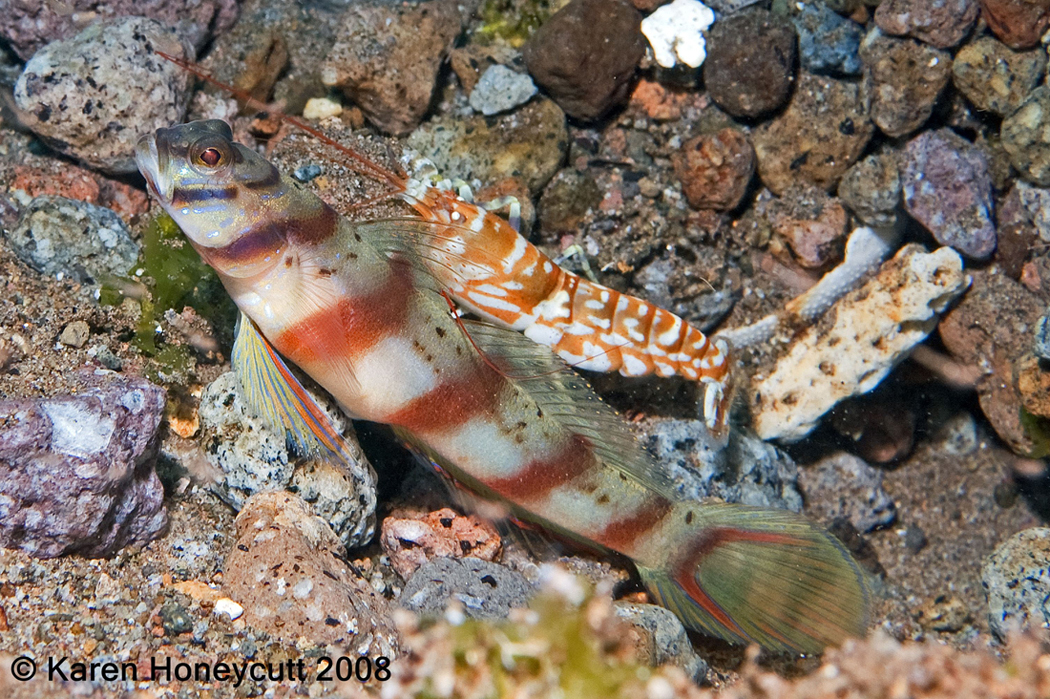- Classification
- ACTINOPTERYGII
- PERCIFORMES
- GOBIIDAE
- Amblyeleotris
- diagonalis
Diagonal Shrimpgoby, Amblyeleotris diagonalis Polunin & Lubbock 1979
Other Names: Diagonal Shrimp Goby, Diagonal Shrimp-goby, Slantbar Shrimpgoby

A Diagonal Shrimpgoby, Amblyeleotris diagonalis, at Dumaguete, Philippines. Source: Karen Honeycutt / FishBase. License: All rights reserved
Summary:
A pale shrimpbogy with two narrow diagonal bands on the snout and cheek, followed by 5 broader reddish to brown bands with brown spots in the interspaces, a yellow anal fin with red and blue margins, and a reddish arc on the caudal fin.
Shrimpgobies share burrows with alpheid shrimps. The shrimp excavates and maintains the burrow, while the goby watches out for predators.
Shrimpgobies share burrows with alpheid shrimps. The shrimp excavates and maintains the burrow, while the goby watches out for predators.
Cite this page as:
Bray, D.J. 2025, Amblyeleotris diagonalis in Fishes of Australia, accessed 02 Jul 2025, https://fishesofaustralia.net.au/Home/species/1181
Diagonal Shrimpgoby, Amblyeleotris diagonalis Polunin & Lubbock 1979
More Info
|
Distribution |
Northern Great Barrier Reef, Queensland, to Sydney Harbour, New South Wales. Elsewhere the species is widespread in the Indo-west Pacific: Red Sea and East Africa to the Solomon Islands, north to the Ryukyu Islands, Japan. Inhabits marine and brackish environments on coastal and offshore reefs, sharing burrows with alpheid shrimps in sandy and coral rubble areas. |
|
Features |
Dorsal fin VII, 13; Anal fin I, 13; Longitudinal scale series 67-75. Greatest body depth 5.2-6.7 in SL; pelvic fins joined by a low basal membrane; predorsal scales extending forward to above posterior margin of preopercle; caudal fin 2.8-3.6 in SL. |
|
Feeding |
Usually feeds by filtering benthic invertebrates from mouthfuls of sand through their gill rakers, or by directly picking invertebrates from the sand. |
|
Biology |
Lives in a symbiotic relationship (commensal) with the alpheid shrimps Alpheus bellulus or A. ochrostriatus - sharing burrows constructed by the shrimps. The gobies seek refuge in the burrows, while the alpheid shrimps receive warning signals from the gobies of oncoming predators. |
|
Etymology |
The specific name is from the Latin diagonalis (= diagonal), in reference to the oblique bands along the body. |
|
Species Citation |
Amblyeleotris diagonalis Polunin & Lubbock, 1979, Bull. Brit. Mus. (N.H.) Zool. 36(4): 245, fig. 4. Type locality: 25 m depth on coarse sand 10-30 m seaward of coral at bottom of reef slope, just east of South Island, Lizard Island, Great Barrier Reef. |
|
Author |
Bray, D.J. 2025 |
|
Resources |
Diagonal Shrimpgoby, Amblyeleotris diagonalis Polunin & Lubbock 1979
References
Allen, G.R. & Erdmann, M.V. 2012. Reef fishes of the East Indies. Perth : Tropical Reef Research 3 vols, 1260 pp.
Karplus, I. 1987. The association between gobiid fishes and burrowing aplheid shrimps. Oceanography and Marine Biology Annual Review 25(1): 507-562.
Kuiter, R.H. 1992. Tropical Reef-Fishes of the Western Pacific, Indonesia and Adjacent Waters. Jakarta : PT Gramedia Pustaka Utama 314 pp. pls.
Kuiter, R.H. 1996. Guide to Sea Fishes of Australia. A comprehensive reference for divers and fishermen. Sydney, NSW, Australia : New Holland Publishers xvii, 434 pp.
Larson, H. 2019. Amblyeleotris diagonalis. The IUCN Red List of Threatened Species 2019: e.T46082241A46664554. Accessed on 14 May 2025.
Polunin, N.V.C. & Lubbock, R. 1979. Five new prawn-associated gobies (Teleostei : Gobiidae) of the genus Amblyeleotris. Bulletin of the British Museum (Natural History) Zoology 36(4): 239-249 figs 1-5 See ref at BHL
Randall, J.E. 2005. Reef and shore fishes of the South Pacific. New Caledonia to Tahiti and the Pitcairn Islands. Honolulu : University of Hawaii Press 707 pp.
Randall, J.E., Allen, G.R. & Steene, R. 1997. Fishes of the Great Barrier Reef and Coral Sea. Bathurst : Crawford House Press 557 pp. figs.








